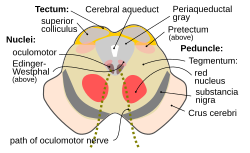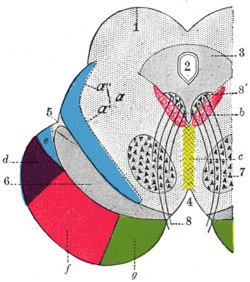
Back سنجابية محيطة بالمسال Arabic Substància grisa periaqüeductal Catalan Periakvaduktální šedá hmota Czech Periaquäduktales Grau German Sustancia gris central Spanish ماده خاکستری اطراف مجرا Persian Substance grise périaqueducale French Sostanza grigia periacqueduttale Italian 수도관주위회색질 Korean Periaqueductaal grijs Dutch
| Periaqueductal gray | |
|---|---|
 Section through superior colliculus showing path of oculomotor nerve. Periaqueductal gray is the gray area just peripheral to the cerebral aqueduct. | |
 Transverse section through mid-brain.
| |
| Details | |
| Identifiers | |
| Latin | substantia grisea centralis |
| MeSH | D010487 |
| NeuroNames | 1584 |
| NeuroLex ID | birnlex_973 |
| TA98 | A14.1.06.321 |
| TA2 | 5909 |
| FMA | 83134 |
| Anatomical terms of neuroanatomy | |
The periaqueductal gray (PAG, also known as the central gray) is a brain region that plays a critical role in autonomic function, motivated behavior and behavioural responses to threatening stimuli.[1][2] PAG is also the primary control center for descending pain modulation. It has enkephalin-producing cells that suppress pain.
The periaqueductal gray is the gray matter located around the cerebral aqueduct within the tegmentum of the midbrain. It projects to the nucleus raphe magnus, and also contains descending autonomic tracts. The ascending pain and temperature fibers of the spinothalamic tract send information to the PAG via the spinomesencephalic tract (so-named because the fibers originate in the spine and terminate in the PAG, in the mesencephalon or midbrain).
This region has been used as the target for brain-stimulating implants in patients with chronic pain.
- ^ Faull, Olivia K.; Subramanian, Hari H.; Ezra, Martyn; Pattinson, Kyle T. S. (2019). "The midbrain periaqueductal gray as an integrative and interoceptive neural structure for breathing". Neuroscience and Biobehavioral Reviews. 98: 135–144. doi:10.1016/j.neubiorev.2018.12.020. hdl:20.500.11850/317617. ISSN 1873-7528. PMID 30611797.
- ^ Silva, Carlos; McNaughton, Neil (2019-02-17). "Are periaqueductal grey and dorsal raphe the foundation of appetitive and aversive control? A comprehensive review". Progress in Neurobiology. 177: 33–72. doi:10.1016/j.pneurobio.2019.02.001. ISSN 1873-5118. PMID 30786258. S2CID 73478335.
© MMXXIII Rich X Search. We shall prevail. All rights reserved. Rich X Search